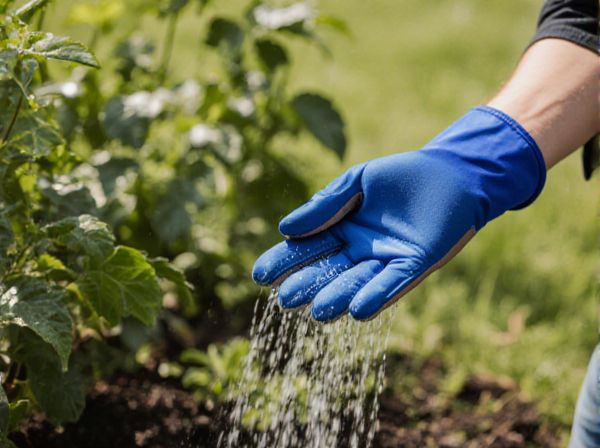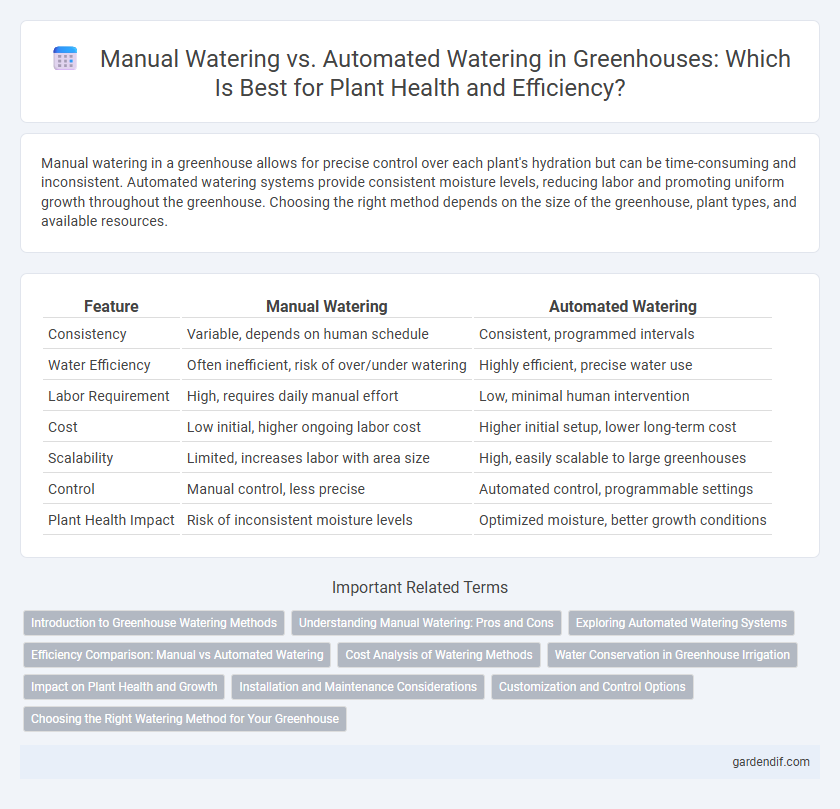
Manual Watering vs Automated Watering Illustration
Manual watering in a greenhouse allows for precise control over each plant's hydration but can be time-consuming and inconsistent. Automated watering systems provide consistent moisture levels, reducing labor and promoting uniform growth throughout the greenhouse. Choosing the right method depends on the size of the greenhouse, plant types, and available resources.
Table of Comparison
| Feature | Manual Watering | Automated Watering |
|---|---|---|
| Consistency | Variable, depends on human schedule | Consistent, programmed intervals |
| Water Efficiency | Often inefficient, risk of over/under watering | Highly efficient, precise water use |
| Labor Requirement | High, requires daily manual effort | Low, minimal human intervention |
| Cost | Low initial, higher ongoing labor cost | Higher initial setup, lower long-term cost |
| Scalability | Limited, increases labor with area size | High, easily scalable to large greenhouses |
| Control | Manual control, less precise | Automated control, programmable settings |
| Plant Health Impact | Risk of inconsistent moisture levels | Optimized moisture, better growth conditions |
Introduction to Greenhouse Watering Methods
Greenhouse watering methods include manual and automated systems, each designed to optimize plant hydration and growth. Manual watering allows for direct control and immediate adjustment based on plant needs, ideal for small-scale or diverse crops. Automated watering systems, using timers or sensors, provide consistent moisture levels, improve water efficiency, and reduce labor for large-scale operations.
Understanding Manual Watering: Pros and Cons
Manual watering in greenhouses offers precise control over water application, allowing gardeners to adjust based on plant needs and soil moisture levels. However, it is labor-intensive and can lead to inconsistent watering schedules, potentially causing stress to plants. While manual watering ensures targeted hydration, it lacks the efficiency and reliability of automated systems, especially in large-scale greenhouse operations.
Exploring Automated Watering Systems
Automated watering systems in greenhouses use sensors and timers to deliver precise amounts of water, optimizing plant growth and conserving resources. These systems reduce labor costs and minimize human error compared to manual watering, ensuring consistent soil moisture levels. Advanced options include drip irrigation and misting technologies that adapt to plant needs, improving efficiency and crop yield.
Efficiency Comparison: Manual vs Automated Watering
Manual watering in greenhouses requires significant labor and time, often leading to inconsistent moisture levels and potential plant stress. Automated watering systems use sensors and timers to deliver precise water amounts, optimizing plant hydration while reducing water waste and labor costs. Studies show automated watering can improve water use efficiency by up to 30%, enhancing overall crop yield and growth uniformity.
Cost Analysis of Watering Methods
Manual watering in greenhouses often incurs higher labor costs due to the time and effort required for consistent watering schedules, making it less cost-effective for large-scale operations. Automated watering systems, while involving initial equipment investment, reduce long-term labor expenses and water waste through precise irrigation control, leading to overall cost savings. Energy consumption and maintenance costs of automated systems should also be considered in a comprehensive cost analysis to determine the best watering method.
Water Conservation in Greenhouse Irrigation
Manual watering in greenhouses often leads to inconsistent water distribution and increased waste, reducing overall water efficiency. Automated watering systems utilize sensors and timers to deliver precise water amounts tailored to plant needs, significantly enhancing water conservation. Implementing drip irrigation or misting technologies within automated systems further optimizes water use by minimizing evaporation and runoff in controlled greenhouse environments.
Impact on Plant Health and Growth
Manual watering allows precise control over the amount and timing of water, reducing the risk of overwatering or underwatering, which directly supports optimal plant health and growth in a greenhouse. Automated watering systems provide consistent moisture levels, promoting steady growth and reducing plant stress by minimizing human error and variability. Research shows that automated systems with sensor technology enhance nutrient uptake and overall plant vigor by maintaining ideal soil moisture conditions.
Installation and Maintenance Considerations
Manual watering in greenhouses requires minimal initial installation but demands consistent labor and attention, which can be time-intensive and prone to human error. Automated watering systems involve higher upfront costs and complex installation, including pumps, timers, and sensors, yet they offer precise water delivery and reduce manual labor over time. Maintenance for automated systems includes periodic checks for clogs, leaks, and calibration of sensors, whereas manual watering only needs basic upkeep of watering tools.
Customization and Control Options
Manual watering in greenhouses offers precise customization through direct human observation and adjustment, allowing growers to respond instantly to plant needs. Automated watering systems provide programmable control options with adjustable schedules, flow rates, and sensor integration for consistent moisture levels. Advanced automation enhances efficiency and reduces labor while retaining flexibility via customizable settings tailored to specific crop requirements.
Choosing the Right Watering Method for Your Greenhouse
Selecting the appropriate watering method for your greenhouse depends on factors such as plant type, size of the greenhouse, and available resources. Manual watering offers precise control and customization for sensitive plant species but can be labor-intensive and time-consuming in larger setups. Automated watering systems, including drip irrigation and misting, provide consistent moisture levels, improve water efficiency, and reduce labor costs, making them ideal for extensive or commercial greenhouses.
Manual Watering vs Automated Watering Infographic

 gardendif.com
gardendif.com